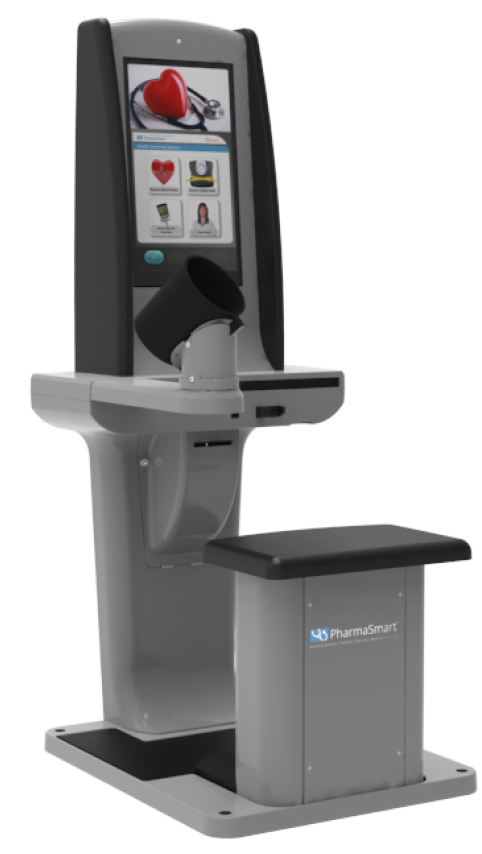ROCHESTER, N.Y. – PharmaSmart International has unveiled new advances in its blood pressure diagnostic and health IT platforms that it said can help pharmacists expand their role as health care providers.
PharmaSmart said this week that it has launched a “breakthrough” blood pressure cuff and an advanced health IT platform. The technology advances improve clinical validity of pharmacy-based hypertension programs; improve patient counseling, education and rates of adherence; and offer “unprecedented” program validation through metrics reporting, according to the company.
PharmaSmart’s latest kiosk offers Internet connectivity, patient data tracking and patient health record integration. “PharmaSmart now combines a clinically validated diagnostic tool with an easy to use health IT platform to offer pharmacists meaningful tools for better patient care. This represents a new era of clinical pharmacy services,” stated Ashton Maaraba, general manager and senior vice president at the company.
“We have added sophisticated patient management without complicating ease of use. We have advanced our health IT platform without confusing our patients or pharmacists. Enrolled patients simply insert their blood pressure management smart card into the kiosk and press start,” Maaraba explained. “The patient consult is just as easy. With one click of a mouse, the pharmacist can initiate a meaningful consultation with a patient about their integrated diagnostic results.”
The recently launched PharmaSmart connectivity network has collected and stored 4 million patient readings, including blood pressure, and the new additions of body mass index (BMI) and blood glucose, the company reported.
PharmaSmart noted that retail pharmacies offering the program have enrolled tens of thousands of patients into its integrated patient management platform. Enrolled patients have access to a retail-branded personal health record that stores and organizes their diagnostic readings. Once patients are enrolled, pharmacists use the integrated Personal Health Record (PHR) functionality to provide informed therapeutic counseling and interventions as required.
“In addition to our suite of pharmacist and patient tools, our IT platform enables robust program reporting,” Maaraba commented. “For example, in 2010, our client networks captured nearly 1.5 million blood pressure readings that were hypertensive. This is a huge, untapped opportunity for pharmacist intervention. We can also track daily program enrollment and patient participation at each store. We offer our retail clients live, store-by-store monitoring to validate program execution. We are able to grow patient participation consistently over time, and our monitoring capability means we can validate it. We have raised the bar in terms of establishing program strategy and validating overall patient engagement for each of our retail partners.”
Maaraba pointed out that PharmaSmart takes a grassroots approach to building patient engagement in clinical services. “We are offering blood pressure care workshops at retailers such as Mariano’s, Roundy’s, Jean Coutu, Astrup Drugs, Smart Med Rx and others. Workshops are also held routinely in employee work sites,” he explained. “These initiatives elevate patient awareness, improve prescription adherence, drive program enrollment and sustain patient engagement. They also reinforce to the participating pharmacy staff how simple and rewarding it can be to engage patients and improve their disease state therapy.”
On the diagnostics front, PharmaSmart has released what it called a breakthrough cuff design for blood presssure testing. “Most people think all blood pressure cuffs are created equal.
The company explained that traditional blood pressure cuffs come in multiple sizes — small, medium and large and that for accurate readings the proper cuff size must be selected for each patient. Yet studies show that in practice this is rarely done and blood pressure accuracy suffers.
PharmaSmart noted that its patented, clinically validated cuff allows accurate measurement of arm sizes from small through large. Its latest cuff is accurate and effective for 97% of the United States adult population, including millions of large patients who are unable to use current blood pressure measurement kiosks.
“In 2005, a Mayo Clinic researcher published a critique of pharmacy blood pressure kiosks, pointing out that the cuffs are too small. Most kiosks found in pharmacies were designed in the 1980s for average adult arm sizes before the obesity trend of the last 25 years,” Sarkis stated. “According to published research, the leading pharmacy blood pressure kiosk accommodates only 63% of American adults and only 50% of hypertensive patients. Patients have grown dramatically in size, but the technology has not grown with them. We are proud that our blood pressure kiosk can now accommodate 97% of American adults.”
He added that PharmaSmart’s new cuff design positions it as a medical-grade, clinical tool for out-of-office blood pressure testing.
“Our objective is to help elevate the role of the pharmacist as a proactive health care provider and as an educator offering meaningful critical disease state management services.”
Link Source: PharmaSmart Highlights Diagnostic Tech Advances 2.2.11







